

HYBRID CHARGING STATION
Mr. Aditya Babaji Dange1, Mr. Kannesh Sharad Sawant2, Mr. Karishma Prakash Rawool 3 , Mr. Mayuresh Umesh Ludabe 4, Mr. Ganesh Vijay Akerkar 5 , Mrs T R Shenai 6
1-5Student, Yashwantrao Bhonsale Institute of Technology, Sawantwadi, Maharastra,India
6Faculty, Yashwantrao Bhonsale Institute of Technology, Sawantwadi, Maharastra, india,
Abstract - TheHybridChargingStationisacutting-edge solution designed specifically for laptops and mobile phonesthatprovidesasinglepowersourceforavarietyof electronic devices. With its integrated USB ports and Qi wireless charging pads, the station is compatible with a wide range of devices and supports many charging standards. The application of intelligent charge managementoptimizespowerdistribution,guardsagainst overcharging, and boosts overall effectiveness. By using sophisticated sensors to detect the presence of devices automatically, the station emphasizes user convenience and streamlines the charging process. Its environmentally friendly design uses sustainable materials and energysavingelementstocreateamoreenvironmentallyfriendly space. The Hybrid Charging Station solves the drawbacks of device-specific charging stations and encourages resource efficiency by combining the infrastructure for charging. Because of its adaptability, the station can be used in a variety of settings, such as homes, workplaces, andpublicareas.Becauseofitsversatilityandscalability,it is at the forefront of offering modern users a complete charging solution. Reducing electronic waste is one of the station's primary contributions to sustainable technology practices. All things considered, the Hybrid Charging Station is a practical, environmentally responsible, and effectiveanswertothechangingdemandsofconsumersof electronicdevices.
Key Words: HYBRID, USB PORTS, QI WIRELESS, STATION ENERGY, EFFICIENCY.
1.INTRODUCTION
This concept presents a state-of-the-art hybrid charging station intended to offer sustainable and environmentally friendly power options for computers and mobile phones. Inordertoguaranteecontinuouschargingcapabilities,the system makes use of both solar and wind energy sources, regardless of changing climatic circumstances. Photovoltaic panels are used at the charging station to collect solar energy during the day. These panels are arranged in a way that maximizes their absorption of sunlight,generatingthemostenergypossibleall daylong. Tofullyutilizethepotential ofsolarandwindresources,a vertical-axiswindturbine is alsoaddedinto the system to generate wind energy. The charging station has clever energy management and storage features to improve effectivenessanduser-friendliness.High-capacitybatteries
are used to store excess energy produced during peak conditions, guaranteeing a steady power supply even during times of low sunshine or wind activity. With its ability to support numerous devices at once, the station provides consumers with an easy-to-use and convenient chargingsolution.
2.OBJECTIVES
• To create a green charging station
• To install charging stations that are convenient andeffectiveinpublicareas.
• To offer long-term solutions to people's billing issues.
3.BLOCK DIAGRAM
Solar panels are used by hybrid charging stations, and theyarepositionedinasunnyarea.Sunlightiscapturedby these panels and transformed into electricity. A device known as a charge controller processes the power producedbythesolarpanels.Thiscontrollermanagesthe voltage and current as well as the flow of electricity to prevent overcharging the batteries. Batteries are used to store electricity. By storing energy produced during the day for use when the sun isn't shining, these batteries functionasapowerbank.Youconnectatinygadgettothe solar charging station in order to charge it, such as a smartphoneorsmallappliance.Usingthechargingstation, your little device is charged using the electricity that has been stored in the batteries. It functions similarly to pluggingadeviceintoanelectricaloutletexceptthatsolar energy is used. By employing this configuration, you may lessen your need on conventional power sources by charging your tiny devices with clean, renewable energy from the sun. To put it simply, solar charging stations use sunshine to charge batteries. You can then use the energy that is stored to charge other tiny devices. This is a practical and environmentally friendly way to power your electronics. International Research Journal of

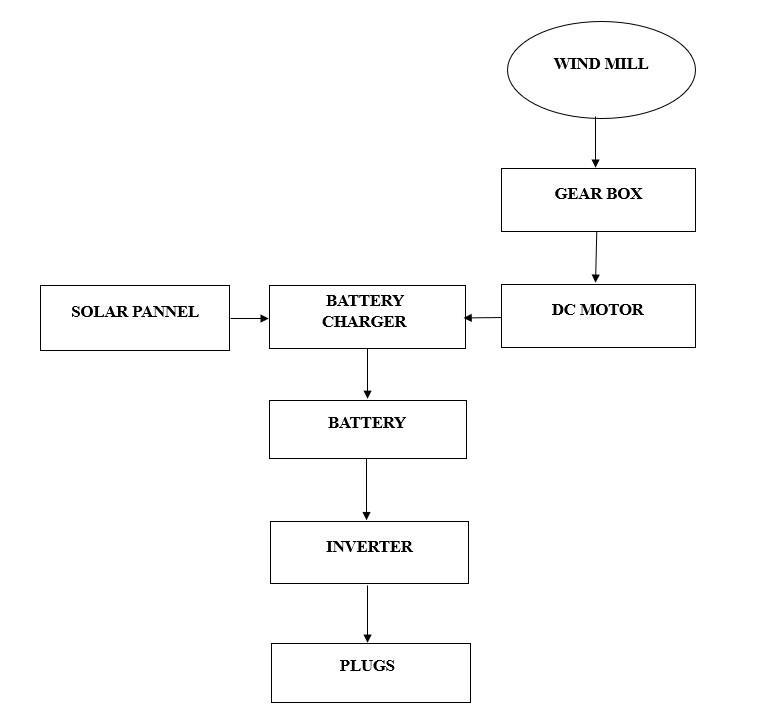
4.COMPONENTS
4.1SOLAR
PANNEL
Sunlight Panel Solar energy is converted into electrical energy using a solar cell. Another name for it is a photovoltaic cell. A junction diode with a thick layer of ntype semiconductor and a very thin layer of p-type semiconductor makes up a photovoltaic cell. Next, a few electrodes should be applied to the p-type semiconductor layer's top. Photons of light can readily pass through the extremely thin p-type layer and enter the p-n junction whenlight arrives. The photons'light energy provides the connection with enough energy to form many electronhole pairs. The junction's state of thermal equilibrium is broken by the incident light. The n-type side of the junction may get free electrons from the depletion zone. Likewise,thep-typesideofthejunctionmaybewherethe holesinthedepletionoccur.Onceonthen-typeandp-type sides, respectively, the recently generated free electrons and holes arrive. Due to the junction's potential barrier, they are unable to cross it. The p-n junction will function likealittlebatterycellwhentheconcentrationofelectrons increases on one side. When the load is linked, a voltage knownasphotovoltaicisbuiltupalongwithatinycurrent flow. A module is the quantity of solar cells connected in parallel or series (solar panel). An array is the number of modulesconnectedinparallelorseries.
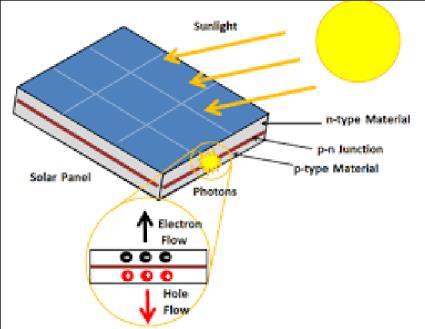
4.2Wind Turbine
One renewable energy source is wind. The kinetic energy of the wind is transformed into electrical energy using a windturbine.Thegenerator,whichisattachedtotheblade shafts, transforms mechanical energy into electrical energy. There are two types of wind turbines: horizontal axis wind turbines and vertical axis wind turbines, which are based on the directionin whichthe blades rotate. The wind's speed determines the wind turbine's output. The turbine's output varies in power. The electric energy neededtosupplytheloadwithcontinuouspowerisstored in a rechargeable battery. Figure 3 depicts the model of a windturbine.

4.3Battery
Electricity generated by solar and wind energy sources is stored in batteries. The size of the solar panel and wind turbine employed determines the battery's capacity. Battery leakage is minimal and maintenance is minimal. Thequantityofbatteriesconnectedinparallelorseriesto alter a battery's capacity based on the hybrid system's output.
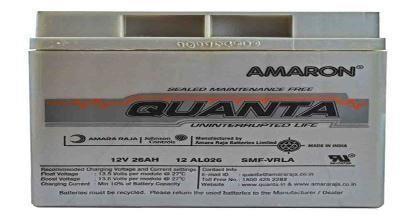
Fig.1 block diagram
Fig.2 solar panel
Fig.3wind turbine
Fig.4 batter

Volume: 11 Issue: 03 | Mar 2024 www.irjet.net
4.4Inverter
The electric energy contained in batteries is transformed from dc to ac via an inverter. Since the power is provided by a DC source, this device is unable to produce any form of power. Certain circumstances, such as low DC voltage, prevent us from using low DC voltage in any of our household appliances. This means that each time we use thepowergenerator,wecanuseaninverter.
4.5Charge Controller
The primary function of a charge controller is to regulate the source's activity or inactivity. It simultaneously provides electricity for loading and charges the battery. Additionally, it should take power from the battery and deliverittotheloadwhenthepowerisnotproducing.
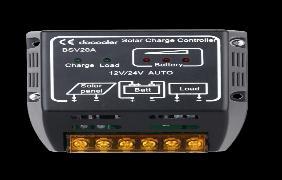
4.6AC-DC Convertor
The dc electricity is changed into ac power using this acdcconverter.Weobtaindcpowerfromthisprototype,and since the load needs an ac supply, an ac-dc convertor is needed to convert it There is no power generated by this converter.Thereisjustonesourceofpower aDCone.

4.7Actual Image:
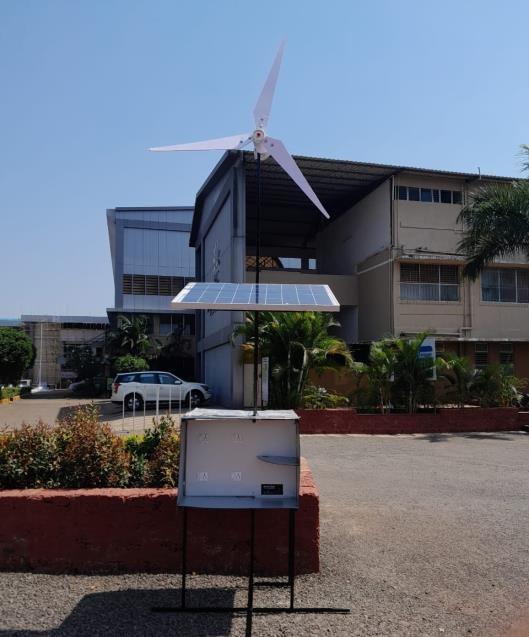
5.
CONCLUSIONS
Smart device hybrid charging stations resemble superchargers for our electronics. They provide us with a variety of options for charging our tablets, phones, and other electronic devices. These incredibly adaptable charging stations are compatible with nearly any location, including parking lots, public spaces, and college campuses.Thefutureofsustainableandconvenientsmart device charging in public spaces is hybrid charging stations. These charging stations provide a variety of charging options to meet the demands of those on the go, including professionals, students, travelers, and more. Smart device hybrid charging stations resemble superchargers for our electronics. They provide us with a variety of options for charging our tablets, phones, and otherelectronicdevices.
6. FUTURE SCOPE
Withthissystem,wemayincludeananti-theftmechanism tokeepthievesfromstealingordestroyingit.Usingimpact sensors, it detects immediately if it is being moved by an unauthorized person or if someone is attempting to destroy it. We can give it an AI feature .We could add a chargingstationtoit.
7.REFERENCES
“Charging Scheduling of Hybrid Energy Storage Systems for EV Charging Stations” Published: 16 September 2023 publishedby:R.Muthammal
Fig.5charge controller
Fig.6inverter
Fig.7actual image

International Research Journal of Engineering and Technology (IRJET) e-ISSN: 2395-0056
Volume: 11 Issue: 03 | Mar 2024 www.irjet.net p-ISSN: 2395-0072
“ Solar and Wind Energy Based Charging Station for Electric Vehicles” Published : 1 jan 2018 published by: C. Chellaswamy,V.Nagaraju,R.Muthamma.
“ Solar and wind energy based smart electric vehicle charging station” Published: 8/05/2022 published by :RiddhiBedmutha
A. H. Elbatran, m. arif ismail “hydro power and turbine system reviews”, jurnal teknologi, 74:5(2015) 83-90, Eissn21803722.
chiyembekezos.Kaunda,torbjornk.Nielsen,“hydropower in the context of sustainable energy supply: A review of technologies and challenges, ISRN renewable energy, volume 2012, article id 730631, doi: 10.5402/2012/7330631.
E.A. Dinesh kumara, nandita hettiarachchi, “review paper: overview of vertical axis wind turbines” IJSRIT, ISSN:23133759,vol.4,no.8;august2017
© 2024, IRJET | Impact Factor value: 8.226 | ISO 9001:2008
| Page381
